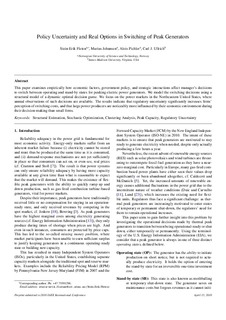| dc.contributor.author | Fleten, Stein-Erik | |
| dc.contributor.author | Johansen, Marius | |
| dc.contributor.author | Pichler, Alois | |
| dc.contributor.author | Ullrich, Carl J. | |
| dc.date.accessioned | 2017-11-16T13:55:36Z | |
| dc.date.available | 2017-11-16T13:55:36Z | |
| dc.date.created | 2016-08-02T11:08:37Z | |
| dc.date.issued | 2016 | |
| dc.identifier.citation | IAEE International Conference. 2016, . | nb_NO |
| dc.identifier.issn | 1559-792X | |
| dc.identifier.uri | http://hdl.handle.net/11250/2466724 | |
| dc.description.abstract | This paper examines empirically how economic factors, government policy, and strategic interactions affect manager’s decisions to switch between operating and stand-by states for peaking electric power generators. We model the switching decisions using a structural model of a dynamic optimal decision game. We focus on the power markets in the Northeastern United States, where annual observations of such decisions are available. The results indicate that regulatory uncertainty significantly increases firms’ perception of switching costs, and that large power producers are noticeably more influenced by their economic environment during their decision-making than small firms. | nb_NO |
| dc.language.iso | eng | nb_NO |
| dc.publisher | International Association for Energy Economics | nb_NO |
| dc.title | Policy Uncertainty and Real Options in Switching of Peak Generators | nb_NO |
| dc.type | Journal article | nb_NO |
| dc.description.version | submittedVersion | nb_NO |
| dc.source.pagenumber | 13 | nb_NO |
| dc.source.journal | IAEE International Conference | nb_NO |
| dc.identifier.cristin | 1370060 | |
| dc.relation.project | Norges forskningsråd: 228811 | nb_NO |
| dc.description.localcode | This is a submitted manuscript of an article published by International Association for Energy Economics in IAEE International Conference, 2016 | nb_NO |
| cristin.unitcode | 194,60,25,0 | |
| cristin.unitname | Institutt for industriell økonomi og teknologiledelse | |
| cristin.ispublished | true | |
| cristin.fulltext | preprint | |
| cristin.qualitycode | 1 | |
